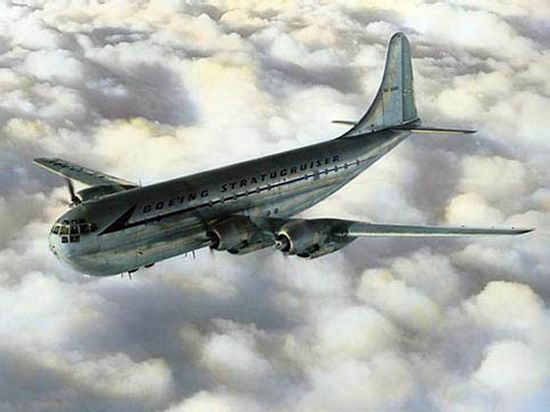|
||||||||||
|
|
||||||||||
|
||||||||||
|
|
||||||||||

In researching this question, I learned that the Stratocruiser, a commercial derivative of the B-29 Superfortress, had a maximum cruising speed of 340 mph (547 km/h), but a typical cruising speed of only 300 mph (483 km/h). This is not uncommon since airlines like to fly their planes at the most fuel efficient speed which is usually quite a bit lower than the maximum velocity. I then performed the same calculations as John did above, and came to pretty much the same conclusions, with average speeds around 220 to 230 mph (350 to 370 km/h). Much like the LA to Bombay trip, the flight from London to NY is affected by headwinds since the aircraft is traveling east to west, which is against the prevailing winds. Since the Stratocruiser only cruises around 300 mph (480 km/h), a head wind of 70 to 80 mph (110 to 130 km/h) would account for the decreased average speeds. Such wind velocities aren't all that uncommon at altitude.

In additon, there is another important factor to consider that I didn't mention in the LA to Bombay question, but plays a more significant role in John's question. When the cruising speed of an aircraft is given, it is important to note that this is the cruising speed only after the aircraft reaches cruising altitude. When we consider the flight time from airport to airport, we also have to take into consideration the time for takeoff, climb, traffic avoidance, loiter, descent and landing. In the case of airline schedules, which list time from gate to gate, we also have to consider taxi time while on the ground. In other words, on shorter trips, the aircraft only spends a fraction of its travel time at the cruising speed. Most of the time is spent traveling much slower, which greatly affects the average speed. This fact explains why the average speed from London to Shannon is so much slower than that from Shannon to New York--a much greater percentage of that first leg is spent at conditions other than cruise flight.
Since this question has been asked more than once, I thought I would add some more evidence concerning this "phenomenon" of differing travel times. I checked the schedule of an airline that flies from Chicago O'Hare to London Heathrow, roughly a 3,950 mile (6,355 km) trip. I checked the departure and arrival times of a Boeing 777, which has an advertised cruise speed of 560 mph (900 km/h). After figuring the time elapsed of each trip, I found that the average speed of the trip from Chicago to Heathrow is about 525 mph (845 km/h), while the average speed of the return trip is only about 440 mph (710 km/h)! Notice that not only are both trips considerably slower than the published cruise speed, but the return trip average speed is over 80 mph slower than the original flight!
On a more anecdotal level, I have a friend who is a flight attendant that told me her most recent trip from Philadelphia to Phoenix (east to west) took over 5 hours, due to "160+ mph" headwinds! This translates into an average speed of about 415 mph (665 km/h) for an aircraft whose published cruise speed is around 525 mph (845 km/h)!
The bottom line--pretty much any trip you take is going to take longer than the math says it will, and when you are
flying in the sky, you are at the mercy of the wind, whether it is with you or against you.
- answer by Doug Jackson, 16 December 2001
Related Topics:
Read More Articles:


|
Aircraft | Design | Ask Us | Shop | Search |

|
|
| About Us | Contact Us | Copyright © 1997-2023 | |||
|
|
|||